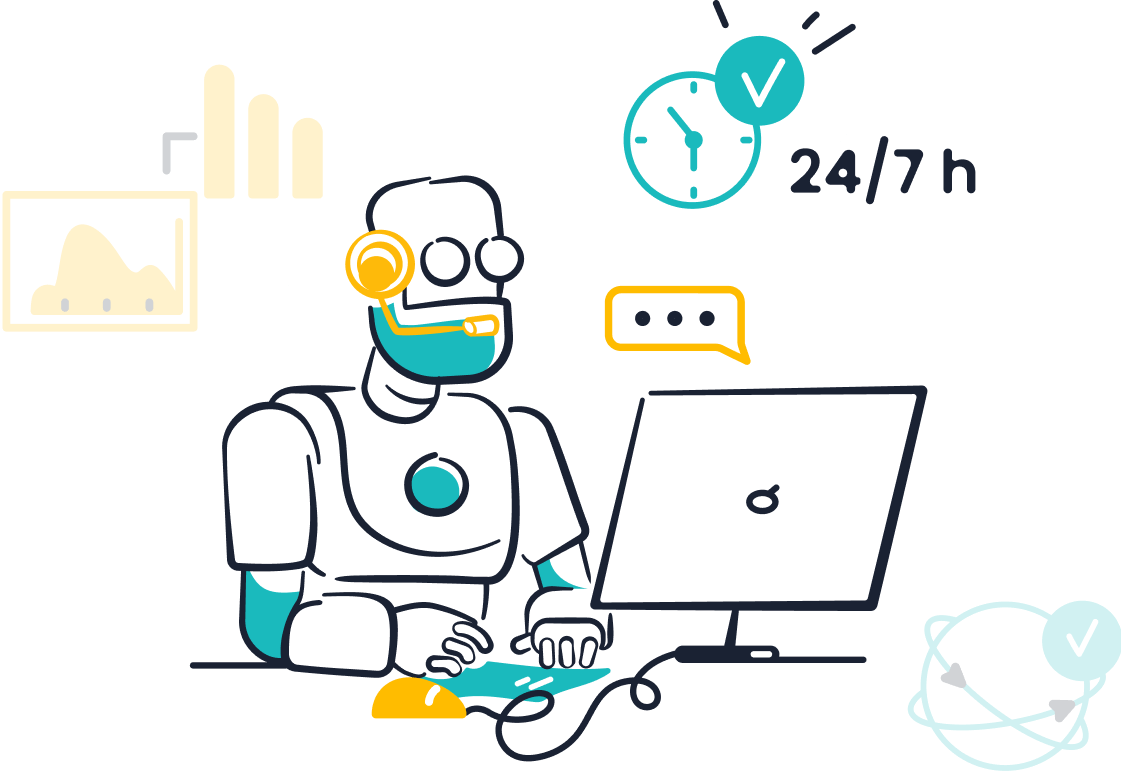Hidden Cons of Chatbots You Can't Ignore

Businesses adopt chatbots to lower costs, with some seeing a 30% reduction in support expenses. The global chatbot market is growing rapidly.

However, companies must ask, what are the cons of chatbots? These tools can frustrate customers and create serious security risks. Understanding these hidden risks is the first step. A professional platform like the Sobot call center, powered by secure Sobot AI, offers a path to better security and customer trust.
WHAT ARE THE CONS OF CHATBOTS FOR CUSTOMER EXPERIENCE

When businesses ask, "what are the cons of chatbots?", the answer often begins with the customer experience. While designed to help, poorly implemented chatbots frequently create more problems than they solve. They can damage customer relationships in ways that are difficult to repair.
Handling Complexity and Nuance
Basic chatbots excel at answering simple, repetitive questions. However, they often fail when faced with complex or non-standard queries. This limitation can trap customers in frustrating conversational dead ends, commonly known as "doom loops." Modern AI chatbots perform well in simple conversations but struggle with tasks that require deep expertise.
For example, a chatbot might fail at these tasks:
- Interpreting the specific nuances of a legal contract.
- Providing functional code for a complex API integration.
- Understanding exceptions to a company policy.
Misinformation and Liability
One of the most significant cons of chatbots is their potential to provide false information. AI models can "hallucinate," meaning they generate confident but factually incorrect statements. The estimated hallucination rate for some large language models is between 15% and 20%. This can lead to serious consequences.
Imagine a customer chatbot telling a user the wrong return policy or an incorrect service fee. This misinformation directly impacts customer behavior and erodes brand trust. Negative experiences often lead to brand avoidance and public complaints.
This issue goes beyond customer frustration and enters the legal realm. A company is responsible for the information its chatbot provides. The case of Moffat v. Air Canada provides a clear example.
| Case | Ruling | Basis for Liability |
|---|---|---|
| Moffatt v. Air Canada | Air Canada was held liable for misleading information from its chatbot. | The tribunal found the company made a negligent misrepresentation. It confirmed that a business is responsible for all information on its website, including from its chatbots. |
Blocking Access to Humans
Many chatbot systems are designed to deflect customers and prevent them from reaching a human agent. This strategy prioritizes short-term cost-cutting over long-term customer satisfaction. The result is a high-friction experience that damages brand loyalty. Over half of users report being unable to reach a human after a chatbot fails. Another study found that 80% of consumers felt more frustrated after interacting with chatbots.
These experiences are not just statistics; they represent real people facing real problems.
"[I] tried the online chat feature - I ran into loop after loop of the same questions, all of them redirecting me to login to solve my problem. I don't have an account, how can I login? Absurd."
"I tried the chat feature and the virtual assistant kept sending me in circles. This is very frustrating and now I am going to get a late fee because I can not get in contact with anyone to pay my bill."
When customers feel trapped by a machine, their perception of the brand suffers. They see a company that does not value their time or business. Answering what are the cons of chatbots must include this critical failure. It shows a disconnect between a company's goals and its customers' needs, ultimately pushing valuable customers away.
SECURITY RISKS AND PRIVACY CONCERNS

Beyond the customer experience, the most critical cons of chatbots involve major security risks and privacy concerns. Chatbots are gateways to vast amounts of data, making them a prime target for cyberattacks. Businesses must understand these data risks to avoid severe financial and legal consequences.
Understanding Data Risks
Chatbots often act as frontline data collectors. They handle sensitive user data during routine interactions. This information can include:
- Names, email addresses, and phone numbers
- Physical home and billing addresses
- Financial data like credit card and bank account numbers
- Login credentials and passwords
- Social Security numbers and other ID data
This concentration of information creates significant security risks. Cybercriminals view chatbots as a valuable entry point to a company's network. A successful attack can expose confidential client information, leading to devastating data breaches. The average cost of a data breach has climbed to $4.88 million, a figure that can cripple a business.
Recent incidents show these vulnerabilities are not theoretical. In one case, attackers exploited a chatbot integration to steal customer contact information from over 700 organizations. These attacks often succeed by exploiting common vulnerabilities, including weak credentials, exposed APIs, and social engineering tactics like phishing. Attackers use phishing to trick users or employees into revealing sensitive information. The growing threat of phishing makes robust security essential for any chatbot platform.
Regulatory and Compliance Violations
The failure to protect customer data brings serious regulatory exposure. Governments worldwide have enacted strict data protection laws with severe penalties for non-compliance. Two of the most important regulations are the GDPR in Europe and HIPAA in the United States.
Under GDPR, companies face fines of up to €20 million or 4% of their global annual turnover for mishandling data. Several companies have already faced massive penalties for violating these policies.
| Company | Violation Details | Fine Amount |
|---|---|---|
| Foodinho | Used employee management algorithms without proper transparency. | €2.6 million |
| Easylife Limited | Inferred customer medical conditions from purchase history for marketing without consent. | £1.48 million |
For industries like healthcare, the Health Insurance Portability and Accountability Act (HIPAA) sets strict rules for chatbots. A HIPAA-compliant chatbot must ensure the confidentiality of patient data, use clear language, and provide a secure handoff to human agents when needed. Mishandling data not only violates regulatory policies but also destroys patient trust. These privacy risks require careful management of data collection and clear privacy disclosures to obtain valid user consent.
Mitigating Risks with Sobot

Addressing these complex privacy and security risks requires more than a basic chatbot. It demands a professional, secure platform built with data protection at its core. Sobot's AI solution offers a clear path for businesses to mitigate these dangers effectively.
Tip: A secure platform is your first line of defense. It turns potential liabilities into a foundation of trust.
Sobot designs its chatbots and AI platform with security as a priority. The system helps businesses meet stringent regulatory requirements, including GDPR compliance. Key features that enhance data protection and security include:
- Advanced Encryption: Sobot protects data both in transit and at rest, ensuring confidentiality at every stage.
- Secure Generative AI: The platform uses generative AI powered by advanced LLMs within a secure framework, preventing the accidental exposure of sensitive information.
- Data Minimization Policies: The system is designed to adhere to data minimization principles, collecting only the necessary information to reduce privacy risks.
By choosing a platform like Sobot, businesses can deploy powerful chatbots without creating unacceptable security risks. Sobot provides the tools to automate interactions safely, protecting both the company and its customers from the growing threats of phishing and data breaches. This commitment to security and compliance allows businesses to leverage the benefits of chatbots while upholding their data protection responsibilities.
THE TRUE BUSINESS IMPACT OF CHATBOT FAILURES
The consequences of poor chatbot performance extend far beyond frustrating a few customers. The true business implications are severe. They create direct financial losses, destroy brand trust, and lead to long-term revenue decline. Understanding this full impact is crucial for any company using chatbots.
Direct Financial Costs
Failed chatbots create significant financial burdens. When a chatbot cannot resolve an issue, a human agent must step in. This means the company essentially pays twice for one interaction. These rework costs add up quickly. Businesses also face legal liability from chatbot errors. A chatbot providing incorrect policy information can lead to expensive lawsuits and forced customer compensation. These direct costs show that poorly implemented chatbots are not a cost-saving tool but a financial drain.
Erosion of Brand Trust
Brand trust is a valuable asset. Bad chatbots can destroy it with a single negative interaction. Research shows that 30% of customers will switch to a competitor or abandon a purchase after a poor chatbot experience. This creates immediate reputational damage. Customers quickly share their frustrations on social media. Public complaints about chatbot outages or inaccuracies can cause a brand's public sentiment to plummet.
A brand's reputation is built over years but can be damaged in moments. Ineffective chatbots accelerate this erosion of trust by making customers feel ignored and undervalued.
This negative feedback loop shows the serious risks chatbots pose to a company's image.
Long-Term Revenue Loss
The financial damage from bad chatbots is not just a short-term problem. Lost customers often do not return. The erosion of brand trust leads to a steady decline in customer loyalty and lifetime value. Each customer who leaves due to a frustrating chatbot experience represents lost future revenue. Over time, this churn significantly affects a company's bottom line. The initial savings from deploying cheap chatbots are quickly erased by the long-term loss of valuable business.
Answering "what are the cons of chatbots?" reveals poor customer experiences, significant security risks, and major privacy issues. A poorly implemented strategy using basic chatbots tanks conversions and destroys trust. Businesses must balance automation and experience.
A balanced approach is key. Use advanced, secure chatbots like Sobot for simple tasks. This frees human agents for complex issues, mitigating the risks of ineffective chatbots.
Embark on Your Contact Journey wisely. Prioritize both efficiency and customer privacy and security to build a successful, trustworthy brand.
FAQ
What are the main cons of using chatbots?
The primary cons of chatbots involve three areas. They can create a poor customer experience with repetitive loops. Chatbots also introduce serious security and privacy risks. These failures ultimately lead to financial loss and damage a brand's reputation.
How do chatbots create security risks?
Chatbots often collect sensitive user data like names, addresses, and financial details. This makes them a prime target for cyberattacks. A breach can expose customer information, leading to severe financial and legal penalties for the business.
Can bad chatbots really hurt a business?
Yes. A frustrating chatbot experience drives customers away. When chatbots fail, they erode brand trust and can lead to public complaints. This customer churn results in long-term revenue loss that outweighs any initial cost savings from the chatbots.
How can a business use chatbots safely?
A business can use chatbots safely by choosing a professional platform.
A secure system should offer:
- Strong data encryption
- Compliance with regulations like GDPR
- Secure AI to protect user information
This approach minimizes risks while delivering a better customer experience.
See Also
Discovering the Key Advantages of Integrating Chatbots on Your Website
Unveiling the Ten Major Perks of Website Chatbot Integration
Simple Steps to Effortlessly Implement Effective Website Chatbot Solutions
Elevating E-commerce Customer Happiness Through Intelligent Chatbot Interactions
Your Essential Handbook for Selecting Optimal Chatbot Software Solutions
